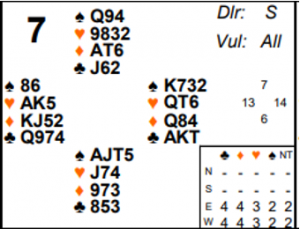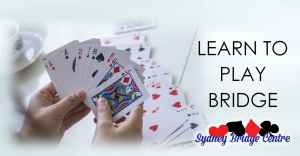City and Canada Bay – Monday Morning 2nd September 2024.

For the 2nd week in a row I’ve picked board 7 to talk about. This week it’s a hand where almost all East West pairs played 3NT. Whilst it could have been beaten, in practice it nearly always made with an overtrick.
The auction is likely to be the same almost everywhere. Uncontested East West 1♣/1♦ – 1♠ – 1NT – 3NT. Those playing weak no-trump would instead bid 1NT – 2♣ – 2♦ – 3NT. That’s if East bothers to bid stayman to look for a spade fit – with his flat shape he might choose to just bid 3NT anyway (personally I would look for spades – just because my hand is 4333 doesn’t mean partner couldn’t have a doubleton somewhere. Indeed if partner was 4423 shape then 3NT could be in trouble on a diamond lead and we might need to play 4♠ instead).
The most common lead from North was a heart. This seems pretty reasonable – East has bid spades but has not attempted to look for a major suit fit after the 1NT rebid. Therefore he probably doesn’t have 4 hearts and only has 4 spades. Hence it’s quite possible the defence has the majority of the hearts. No good here but it’s not over – the defence will get a 2nd chance.
After a heart lead declarer has 3 hearts and 4 clubs (although he doesn’t yet know they are breaking 3-3). So he needs 2 more tricks. They can clearly come from diamonds so that’s what declarer will play on. North can afford to duck one diamond (and it’s good to do so – see advanced section for why) but he must take the 2nd otherwise declarer will already have 9 tricks. Now North needs to switch to spades for the defence to have any hope of beating the contract. They can in fact then take 4 spade tricks.
Can North realistically find a spade switch? Not easy! It’s likely that the pair will need to be playing some good defensive signals to be able to get this right. However, he does have some clues. He knows declarer doesn’t have spade support. He can’t be sure of the heart position (trick 1 may have gone something like ♥8,10,J,A – now from North’s perspective it’s possible South started with ♥KJ and that will be the winning continuation). Nor is he sure of the club position but he does know there’s little future there for the defence with ♣AK10 in dummy. He can also surely place declarer with reasonable diamonds because he’s played on the suit. But none of that is enough to be sure South has such good spades!
One signalling technique (Smith Peters) might help the defence get this right. That’s a method where the first signal the defence give when declarer plays a suit is based on whether they each liked their opening lead – not a count signal. See advanced section for more.
At the table it looks like most Norths continued hearts. Now with both clubs and diamonds splitting 3-3 that meant 10 tricks (3 hearts, 3 diamonds and 4 clubs). One or two tables do seem to have held declarer to 9 tricks so they may have led or switched to spades but only taken 3 spade tricks and ♦A. Nevertheless, -600 scored very well when almost every other pair was conceding -630!
To actually take 4 spade tricks North needs to switch to the ♠9! No other card will work – see advanced section for why.
Key points to note
- A 4333 hand opposite a 1NT opening should usually still look for a major fit – partner could easily have a weak doubleton whereupon 4 major will play better than 3NT.
- Tend to lead majors if the opponents have landed in 3NT without looking for a major suit fit.
- If you really want partner to switch to a suit, consider how you might be able to signal that – which might include feigning weakness somewhere else.
- Smith Peters are a defensive method where, when declarer plays a suit, you signal your like/dislike of your side’s opening lead rather than count. They can be the only way to get some hands right.
- Sometimes there is only one card that will maintain the lead in the right hand to be able to continue running a suit – either as declarer or defender. For those interested, it’s worth learning to recognise these positions.
More advanced
So why does North need to play the ♠9 for the defence to take 4 spades and beat 3NT? Try doing anything else. If he leads a low one, South can win but can’t now attack spades. If he plays the ♠Q, declarer can duck. Now South is left with ♠AJ10 so on the next round he will have to win and cannot now attack spades with ♠Kx left in dummy. (If South unblocked the ♠J or ♠10 under the ♠Q, that would allow North to lead the ♠9 next – but now declarer can afford to cover and that leaves dummy with ♠73 and South on lead with ♠J5. But on the ♠9 lead, there’s nothing declarer can do – South can play the ♠5 under it, North holds the lead and next leads ♠Q.
If declarer covers ♠9 with ♠K (unlikely but not impossible), South wins and now needs to put North back in with ♠Q (also difficult to find since the S9 is usually played to indicate no interest in the suit). That enables the defence to take 4 spade tricks.
This spade suit combination is worth examining – you sometimes see it as declarer as well and the right play there to be able to run the suit without wasting entries is by leading the 9 on the first round.
Of course it’s not easy for North to picture this as he can’t see West’s hand. If West had ♠10x instead then North may do better to start with ♠Q. But if that’s the position the defence can’t actually ever take 4 spades to beat the contract. Of course this is where Imps and Matchpoints differ. At imps your primary goal is to beat 3NT so it’s worth playing spades to try and achieve that – if you end up giving 1 or 2 overtricks away in the process then it doesn’t really matter much. Conversely at matchpoints you have a harder decision – i.e. whether to try to beat the contract at all! You might view that it’s always going to make and your best job is to try and minimise any overtricks. If you aggressively switch to spades and find declarer has decent spades, you may well just give overtricks away which are a lot more costly at matchpoints.
Smith Peters are a useful method in defence (usually played only in no-trumps) where, on declarer’s first suit, each defender signals whether they liked the opening lead or not (it’s up to partnership agreement which way round they do this – i.e. whether a high or low card likes the original suit). Provided of course there isn’t a long suit in an otherwise entryless dummy – in which case it’s still more important for the defenders to give count to ensure they take their Ace on the right round to cut the long suit off.
Often the position of the opening lead suit isn’t known after trick 1 (declarer can of course false card or conceal his strength in the suit) so this signal can be essential. On this hand when declarer plays diamonds South could strongly signal that he did NOT like the opening lead. That at least gives North a chance to work out the spade switch.
Even if not playing Smith Peters, South may be able to signal or give some help in other ways.
Firstly he could give some suit preference hints with the cards he plays. When declarer plays diamonds, he should play the 9 and then the 7 – his highest cards each time hinting that he prefers the highest other suit (spades). That’s the reason it is better for North to not take the ♦A immediately – by seeing two cards that his partner plays in the suit he gets a better signal.
Another thoughtful thing South could do at trick 1 is NOT cover the ♥10. It feels intuitive to do so but when you stop and work it out there’s actually no point. After something like ♥8 lead South knows North doesn’t have an honour so declarer has ♥AK. Assuming partner led at least a 4 card suit that gives declarer ♥AK(x) and he therefore has 3 tricks whatever the defence do. As I mentioned earlier if South does cover and declarer wins ♥A then North doesn’t know where the ♥K is and might mistakenly continue hearts. By not covering ♥10 with ♥J South can make it clear he doesn’t hold anything good in hearts. That avoids North thinking his heart lead may have hit the jackpot! Good defenders should try to visualise what things might look like from their partner’s perspective. That may then help them prevent partner from having a problem.
Julian Foster (many times NSW representative)





Great post.